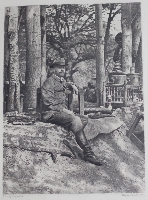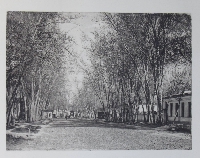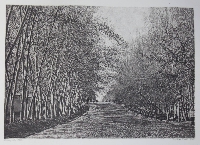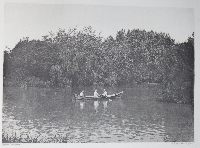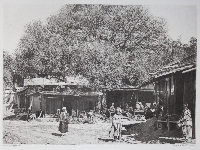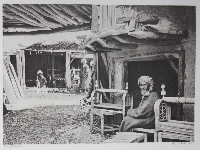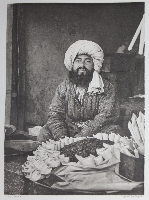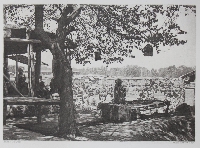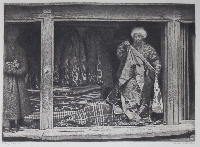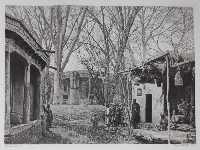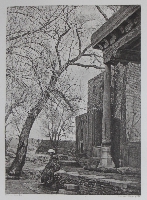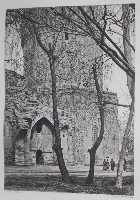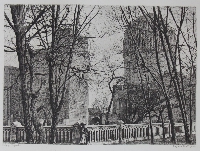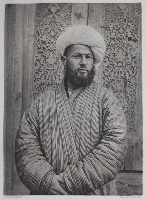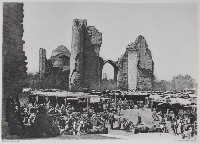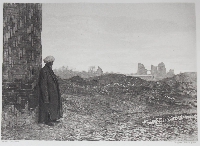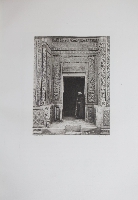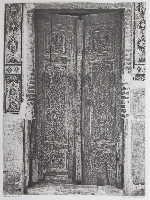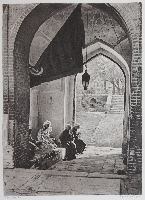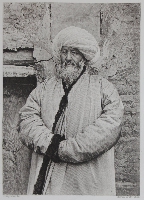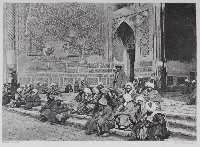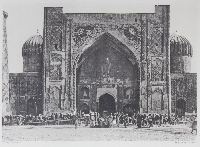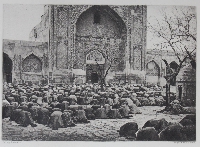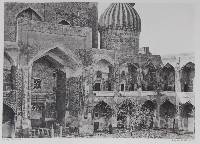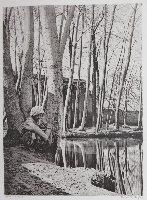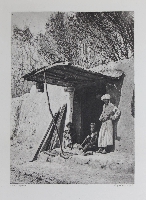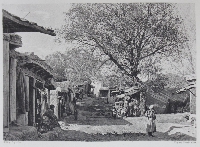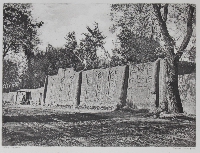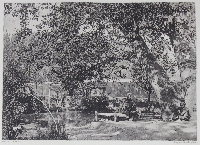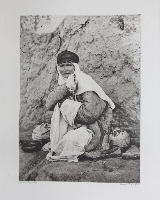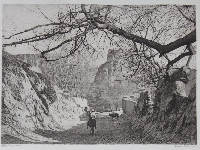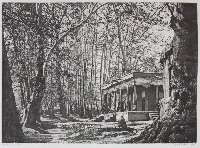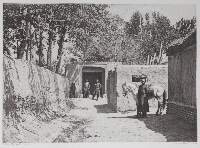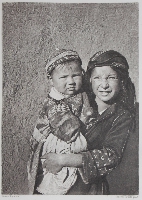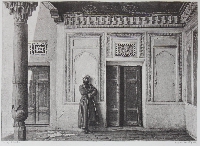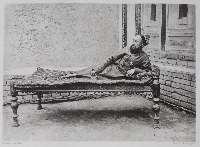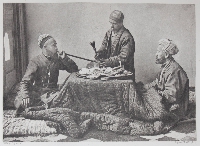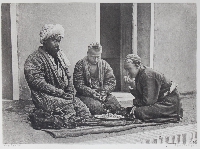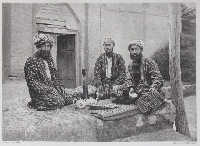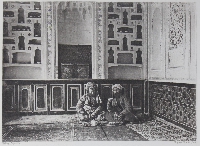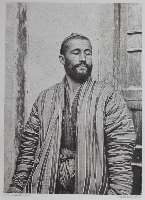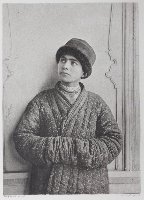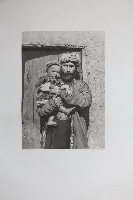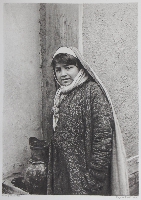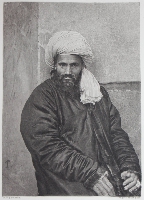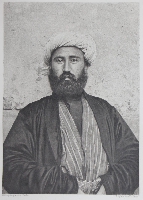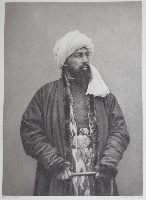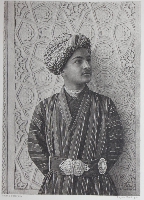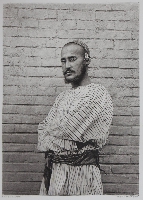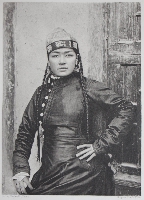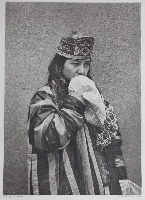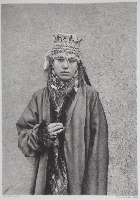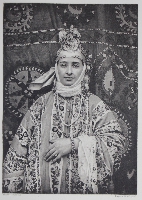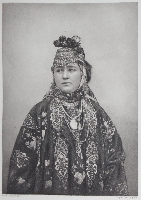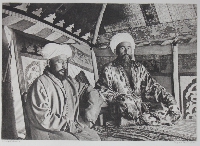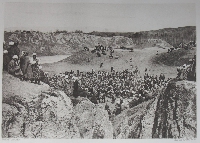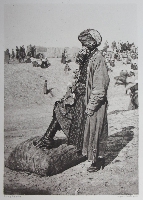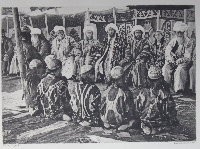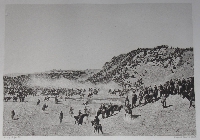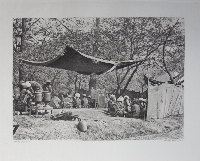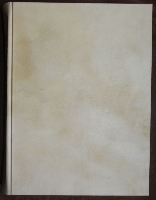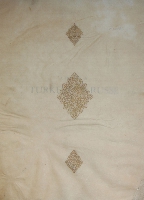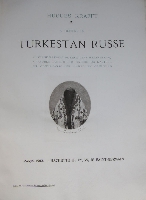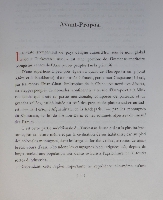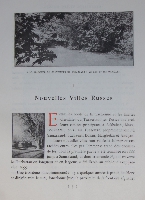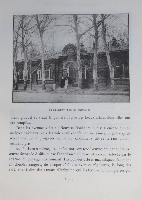A travers le Turkestan Russe
Year: 1902
Edition: First edition
Publisher: Paris; Hachette et Cie.
Category: Asia
A simple, contemporary vellum binding, large 4to, top edges cut, others uncut, half title leaf, frontispiece leaf, title leaf, blank leaf, dedication leaf, pp. vii, (1), 228, 1, (1), 1, (1), plus, interleaved, 70 photogravures on vellum-paper (all shown below; picture nrs 1 - 70). The original parchment wrappers bound in, its spine laid down on the vellum spine.
The dedication leaf reads:
A Madame
la Marquise de Montebello
Cet ouvrage est dédié par l'Auteur
en hommage reconnaissant
et respectueusement dévoué.
A fine example of book printing art. By any standard this book is one of the finest printed books that appeared at the beginning of the 20th century in France.
Parchment sheets decorated with gold cartouches at beginning and end, which actually form the original softcover binding. Title page printed in green and black with a title vignette in heliogravure. Initials printed in red. Complete with the folding colour map of the area.
In 1898 Hugues Krafft, a very wealthy French nobleman and gifted amateur photographer, travelled in Russian Turkestan for several months and visited Samarkand, Bukhara, Tashkent, Kokan, etc. This book is the product of his travels, lavishly illustrated with 70 high-quality photogravures and 195 heliogravures in phototype, showing the people, their dresses, the towns, the mosques and madrassas, as well as the mountains and valleys of these regions. The portraits of the people shown here are magnificent and display the integrity of the photographer; he shows their beauty, their sensitivity.
These photographs are of a high quality. Taken at the end of the 19th century, these pictures provide a unique and fascinating perspective on a region with an impressive history. Although already part of the Russian Empire, from a cultural point of view it all was still rather unspoilt.
From May 11th up till June 14th 1902 Hugues Krafft visited St. Petersburg and Moscow during which period he had a private audience with czar Nicholas II. Here he presented to the czar a copy of this book, sumptuously bound by Gruel, in a morocco slipcase decorated with the imperial eagles which now is in the possession of the Library of Congress.
For his family and friends he had a number of copies bound as well: an exquisite red morocco binding with green sheep leather panels laid in. The panels tooled in blind and gold with three cartouches. The spine with a laid in calf label, bordered in gold and with decorated gilt titles. Gilt inner dentelles at head and tail of spine. Silk doublures and endpapers in typical red and yellow Turkestan design. These copies all with a gift inscription for the recipient.
This book is a work of art in itself, with the 70 photogravures printed on heavy high-quality vellum-paper, creamy white in colour. The paper is watermarked "Marais 1901", while there are the additional watermarks "H. Krafft" (in the form of his signature), "Au Turkestan Russe" and "Hachette". These photogravures are protected by tissue-guards with the captions printed on them in green.
The text and the heliogravures are printed on lighter, high quality paper manufactured in 1901 by Marais as well, with very wide margins.
The intriguing, fascinating and beautiful photographs appear on almost every page.
The colophon states:
Le texte de cet ouvrage a été imprimé
par M. Ch. Hérissey, à Evreux.
Les planches hors texte héliogravure
sortent des ateliers de M. Dujardin, Paris.
Le tirage des planches hors texte a été
exécuté par M. Wittmann, Paris.
Les gravures dans le texte ont été tirées
en phototypie par Mm. Berthaud, Paris
The captions of the 70 plates hors texte and their watermarks are as follows:
1. Portrait de l'auteur. [M]
2. Maisons et magasins de la ville Russe de Samarkand. [K]
3. Une avenue de la ville de Samarkand. [M]
4. Dans le parc de la résidence du Gouverneur militaire de Samarkand. [H]
5. Un carrefour de boutiques indigènes à l'ombre d'un orme noir. [K]
6. Dans les bazars : la ruelle des marchands de berceaux. [T]
7. Marchand de tabac accroupi dans sa boutique. [H]
8. Dans les bazars : l'étalage d'un potier. [H]
9. Un tchai-khané au-dessus du marché au grains de Samarkand. [K]
10. Marchand d'étoffes déployant un khalat. [M]
11. Une mosquée moderne. [T]
12. Le portique en bois d'une mosquée de Samrkand. [M]
13. Le médressé de Khodja-Akhrar, près de Samarkand. [T]
14. Au Tombeau de Tamerlan : vue du dôme. [T]
15. Au Tombeau de Tamerlan : vue d'ensemble du monument. [M]
16. Un moullah, gardien du tomebeau de Tamerlan. [H]
17. La façade et le grand portail du médressé de Biby-Khanim. [M]
18. Les ruines de Biby-Khanim vue du haut plateau, derrière Châh-Zindé. [K]
19. Le grand escalier conduisant à la ruelle des mausolées de Châh-Zindé. [H]
20. Faïences émaillées décorant la façade d'un mauslée de Châh-Zindé. [H]
21. Porte en bois sculpté ouvrant sur la mosquée de Châh-Zindé. [K]
22. Le portique de Châh-Zindé vu du premier palier intérieur. [K]
23. Un vieux moullah de la mosquée de Châh-Zindé. [K]
24. Revêtements de faïences ornant le portail de médressé de Chir-Dar. [M]
25. Grande façade et coupoles du médressé de Chir-Dar. [M]
26. Le prière du vendredi au médressé de Tilla-Kari : les fidèles prosternés. [H]
27. Façade interieur et cour du médressé de Chir-Dar. [M]
28. La chaîne des montagnes au sud-est de Samarkand. [M]
29. Au senil d'une petite mosquée suburbaine. [K]
30. Au bord de la route : l'auvent d'un tchaï-khané. [T]
31. Chemin bordé de boutiques dans un quartier suburbain. [T]
32. Une habitation d'été : le décor des murs de jardin. [T]
33. Grands peupliers ombrageant le bassin d'une mosquée sunurbaine. [M]
34. Une l'épreuse de Samarkand demandant l'aumône. [M]
35. Environs de Siab : un chemin creux. [T]
36. Le torrent d'Ourgout et les montagnes du Hazret-Soultan. [K]
37. La mosquée et le bois sacré de Tchar-Tchinar à Ourgout. [T]
38. Une ruelle dans un faubourg : porte d'entrée d'une maison sarte. [H]
39. Un petit enfant musulman, porté par ine jeune servante. [K]
40. Le vestibule d'un riche marchand de Tachkent. [K]
41. Sarte étende sur un lit de bois colorié. [H]
42. Sartes assis autour du sandali et du plateau à collation. [K]
43. Sartes accroupis sur la terrasse d'une maison et mangeant le palao. [H]
44. Sartes prenant le thé près de l'entrée d'une mosquée. [H]
45. Le salon de reception de l'habitation d'un riche marchand. [M]
46. Un Ouzbeg de Kokan en khalat de soi de plusieurs couleurs. [M]
47. Un jeune Juif de Tachkent portant le bonnet bordé de fourrure. [M]
48. Ouzbeg de Khodjent tenant un enfant dans ses bras. [T]
49. Une fillette Tadjik apportant de l'eau dans une cruche. [T]
50. Un Tadjik de Boukhara revêtu d'un khalat d'hiver. [K]
51. Un Ouzbeg de Djizak portant un vêtement de drap sur un khalat de soie. [H]
52. Un Tadjik de Samarkand en khalat garni de fourrure. [H]
53. Un jeune Tadjik portant la ceinture de soie ornée de plaques d'agent ciselé. [M]
54. Un Tadjik d'Ourgout en vêtement de coronnade. [K]
55. Une femme Ouzbeg de Kokan coiffée du topi. [M]
56. Une jeune femme Ouzbeg de Khodjent coiffée d'un topi brodé d'or. [H]
57. Une femme Tadjik de Samarkand en khalat d'hiver et coiffée d'un diadème en orfèvrerie [K]
58. Une femme Juive de Samarkand en atours de cérémonie. [K]
59. Une femme Juive de Samarkand coiffée d'un diadème de perles et d'émeraudes [K]
60. Une jeune femme Tadjik de Samrkand jouant du doutar. [K]
61. Musulmans assis sous une tente pendant les fêtes du Sâli-Naon. [T]
62. Une course au boue dans le grand ravin d'Afrâsiâb. [T]
63. Un cavalier chaussé de bottes é hauts talons pointus. [K]
64. Le Starchii-Aksakal de Samarkand en grand costume de cérémonie. [M]
65. Divertissement de batcha (danseurs) dans le vestibule d'une maison particulière. [M]
66. La tente de réception à Afrâsiâb, le jour de la grande course du Sâli-Naou. [T]
67. La grande course à Afrâsiâb pendant les fètes du Sâli-Naou. [T]
68. Le bassin de la mosquée de Namaz-Ga pendant la fète du Kourban-Namaz. [T]
69. Un tchai-khané à Namaz-Ga pendant la fète du Kourban-Namaz. [M]
70. La prière matinale du Kourban-Namaz à la mosquée de Namaz-Ga. [K]
Watermarks:
[H] = Hachette & Co
[K] = H. Krafft (in the form of his signature)
[M] = Marais 1901
[T] = Au Turkestan Russe
All watermarks are placed in the lower margin of the leaves with as only exception plate no. 68, where it is placed in the upper margin of that leaf.
We assume that the leaves on which the plates have been printed, were picked at random, so that the watermarks for each plate may differ from copy to copy.
The original binding is a parchment wrapper, as still included in this copy. Quite obviously it was Hugues Krafft’s intention that prospective buyers would have their copies bound after purchasing this book, in which he apparently succeeded as several copies in ornate bindings appeared on the market in the past decades, sometimes lacking the original soft-cover binding. Very occasionally also copies still in their original soft-cover binding come to the market.
Although further research is required it seems reasonable to assume that this Hachette edition was subsidized by M. Krafft, given the fact that the publication of this book, even in those days, from a commercial point of view, must have been a hazardous operation. Moreover his signature, in the form of a watermark, is in the vellum paper on which the photogravures are printed, as well as on the text pages. Obviously this paper was produced by Marais already the year before, as indicated by their watermark.
A truly magnificent book.
Yakushi (1994) K316.
Click on a picture to enlarge.
